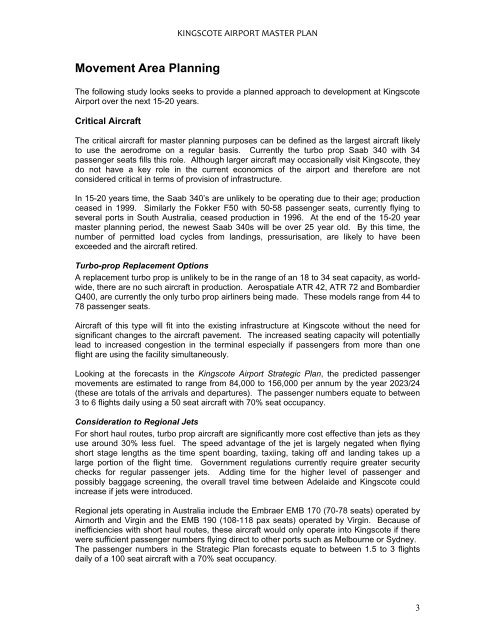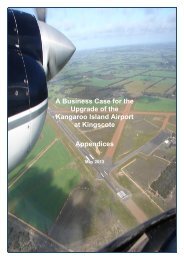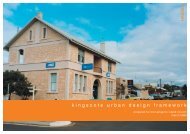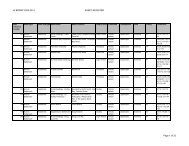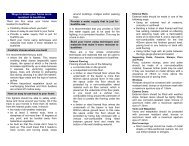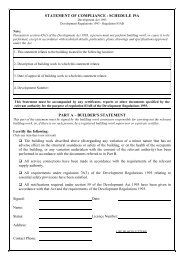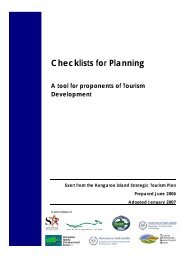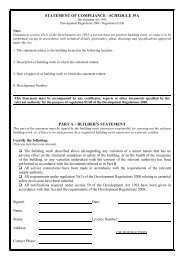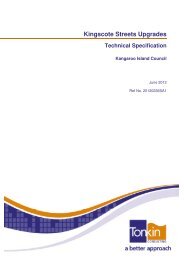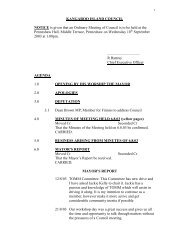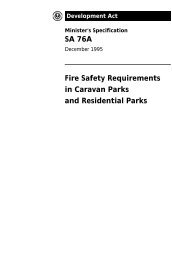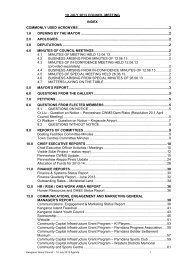Kingscote Airport Master Plan Apr 2010 - Kangaroo Island Council
Kingscote Airport Master Plan Apr 2010 - Kangaroo Island Council
Kingscote Airport Master Plan Apr 2010 - Kangaroo Island Council
You also want an ePaper? Increase the reach of your titles
YUMPU automatically turns print PDFs into web optimized ePapers that Google loves.
KINGSCOTE AIRPORT MASTER PLAN<br />
Movement Area <strong>Plan</strong>ning<br />
The following study looks seeks to provide a planned approach to development at <strong>Kingscote</strong><br />
<strong>Airport</strong> over the next 15-20 years.<br />
Critical Aircraft<br />
The critical aircraft for master planning purposes can be defined as the largest aircraft likely<br />
to use the aerodrome on a regular basis. Currently the turbo prop Saab 340 with 34<br />
passenger seats fills this role. Although larger aircraft may occasionally visit <strong>Kingscote</strong>, they<br />
do not have a key role in the current economics of the airport and therefore are not<br />
considered critical in terms of provision of infrastructure.<br />
In 15-20 years time, the Saab 340’s are unlikely to be operating due to their age; production<br />
ceased in 1999. Similarly the Fokker F50 with 50-58 passenger seats, currently flying to<br />
several ports in South Australia, ceased production in 1996. At the end of the 15-20 year<br />
master planning period, the newest Saab 340s will be over 25 year old. By this time, the<br />
number of permitted load cycles from landings, pressurisation, are likely to have been<br />
exceeded and the aircraft retired.<br />
Turbo-prop Replacement Options<br />
A replacement turbo prop is unlikely to be in the range of an 18 to 34 seat capacity, as worldwide,<br />
there are no such aircraft in production. Aerospatiale ATR 42, ATR 72 and Bombardier<br />
Q400, are currently the only turbo prop airliners being made. These models range from 44 to<br />
78 passenger seats.<br />
Aircraft of this type will fit into the existing infrastructure at <strong>Kingscote</strong> without the need for<br />
significant changes to the aircraft pavement. The increased seating capacity will potentially<br />
lead to increased congestion in the terminal especially if passengers from more than one<br />
flight are using the facility simultaneously.<br />
Looking at the forecasts in the <strong>Kingscote</strong> <strong>Airport</strong> Strategic <strong>Plan</strong>, the predicted passenger<br />
movements are estimated to range from 84,000 to 156,000 per annum by the year 2023/24<br />
(these are totals of the arrivals and departures). The passenger numbers equate to between<br />
3 to 6 flights daily using a 50 seat aircraft with 70% seat occupancy.<br />
Consideration to Regional Jets<br />
For short haul routes, turbo prop aircraft are significantly more cost effective than jets as they<br />
use around 30% less fuel. The speed advantage of the jet is largely negated when flying<br />
short stage lengths as the time spent boarding, taxiing, taking off and landing takes up a<br />
large portion of the flight time. Government regulations currently require greater security<br />
checks for regular passenger jets. Adding time for the higher level of passenger and<br />
possibly baggage screening, the overall travel time between Adelaide and <strong>Kingscote</strong> could<br />
increase if jets were introduced.<br />
Regional jets operating in Australia include the Embraer EMB 170 (70-78 seats) operated by<br />
Airnorth and Virgin and the EMB 190 (108-118 pax seats) operated by Virgin. Because of<br />
inefficiencies with short haul routes, these aircraft would only operate into <strong>Kingscote</strong> if there<br />
were sufficient passenger numbers flying direct to other ports such as Melbourne or Sydney.<br />
The passenger numbers in the Strategic <strong>Plan</strong> forecasts equate to between 1.5 to 3 flights<br />
daily of a 100 seat aircraft with a 70% seat occupancy.<br />
3


